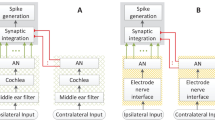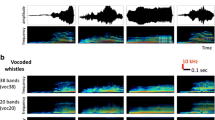Abstract
This paper addresses the question of frequency discrimination of hearing for non-stationary (short) tone stimuli (duration ⩽125 ms). Shortening of the stimulus duration leads to widening of the frequency spectrum of the tone. It can be shown that for hearing no acoustical uncertainty relation holds and thus some nonlinear elements must be present in hearing physiology. We present neurophysiological and psychoacoustical findings supporting the hypothesis that frequency discrimination of non-stationary short tone stimuli is performed in neural networks of the auditory system. Neural network architectures that could process the temporal and place excitation patterns originating in the cochlea are suggested. We show how these networks (temporal coincidence network processing the temporal code and lateral inhibition network processing the place code) can be combined to show performance consistent with auditory physiology. They might explain the frequency discrimination of hearing for non-stationary short tone stimuli. We show the fitting of psychophysical relations based on these networks with the experimentally determined data.
Similar content being viewed by others
References
Blackburn CC, Sachs MB (1990) The representation of the steady-state vowel sound (ɛ) in the discharge patterns of cat anteroventral cochlear nucleus neurons. J Neurophysiol 63:1191–1212
Cardozo BL (1962) Frequency discrimination of human ear. In: Proceedings of the 4th International Congress on Acoustics, Copenhagen
Cody AR, Russell IJ (1987) The responses of hair cells in the basal turn of the guinea-pig cochlea to tones. J Physiol (Lond) 383:551–569
David E, Finkenzeller P, Kallert S, Keidel WD (1969) Reizfrequenzkor-relierte ‘untersetze’ neuronale Entladungsperiodizität im colliculus inferior und im corpus geniculatum mediale. Pflugers Arch 309:11–20
Ehret G, Merzenich MM (1988) Complex sound analysis (frequency resolution, filtering and spectral integration) by single units of the inferior colliculus of the cat. Brain Res 472:139–163
Erulkar SD (1975) Physiological studies of the inferior colliculus and medial geniculate body. In: Keidel WD, Neff WD (eds) Handbook of sensory physiology. auditory system, vol. V/2. Springer, Berlin Heidelberg New York, pp 147–198
Evans EF, Zhao W (1993) Varieties of inhibition in the processing and control of processing in the mammalian cochlear nucleus. Prog Brain Res 97:117–126
Fack H (1956) Informationstheoretische Behandlung des Gehoers. In: Wincker F (ed) Impulstechnik. Springer, Berlin Heidelberg New York, pp 1–128
Gabor D (1946) Theory of communication. J Int Eng 93:429–457
Houtgast T (1974) Lateral suppression in hearing. PhD Thesis, Free University of Amsterdam. Academische Pers. BV, Amsterdam
Ifukube T, White RL (1987) A speech processor with lateral inhibition for an eight channel cochlear implant and its evaluation. IEEE Trans Biomed Eng 34:876–882
Irvine DRF (1992) Physiology of the auditory brainstem. In: Popper AN, Fay RR (eds) The mammalian auditory pathway: neurophysiology. Springer, Berlin Heidelberg New York, pp 153–231
Jeffress LA (1948) A place theory of sound localisation. J Comp Physiol Psychol 41:35–39
Kaluzny J, Majernik V, Kaluzna M (1985) A contribution to the determination of the frequency discrimination ability. Arch Acoust 10:253–258
Katsuki Y (1966) Neural mechanisms of hearing in cats and monkeys. Prog Brain Res 21A:71–97
Keidel WD (1992) Das Phaenomen des Hoerens: ein interdisziplinaerer Diskurs II. Naturwissenschaften 79:347–357
Keidel WD, Neff WD (eds) (1975) Handbook of sensory physiology. Auditory system, vol. V/2. Springer, Berlin Heidelberg New York
Kurogi S (1991) Speech recognition by an artificial neural network using findings on the afferent auditory system. Biol Cybern 64: 243–249
Liang C, Cistovic L (1960) Dependence of the frequency differential thresholds on the duration of the tone signals. Akust Zhur 6:81–85
Majernik V (1967) Die Unschaerferelation fuer das Gehoer. Fyz cas SAV 2:65–73
Majernik V, Kaluzny J (1979) On the auditory uncertainty relations. Acustica 43:132–146
Majernik V, Kral A (1993) Sharpening of input excitation curves in lateral inhibition. Int J Neural Syst 4:65–80
Moore BCJ (1972) Some experiments relating to the perception of pure tones: possible clinical applications. Sound 6:73–79
Moore BCJ (1993) Frequency analysis and pitch perception. In: Yost WA, Popper AN, Fay RR (eds) Human psychophysics. Springer, Berlin Heidelberg New York
Oetinger R (1959) Die Grenze der Hoerbarkeit von Frequenz und Tonzahlaenderungen bei Tonimpulsen. Acustica 9:430–445
Patuzzi R, Robertson D (1988) Tuning in mammalian cochlea. Physiol Rev 68:1009–1082
Phillips DP (1993) Representation of acoustic events in the primary auditory cortex. J Exp Psychol Hum Percept Perform 19:203–216
Rhode WS, Greenberg S (1992) Physiology of the cochlear nuclei. In: Popper AN, Fay RR (eds) The mammalian auditory pathway: neurophysiology. Springer, Berlin Heidelberg New York, pp 94–152
Ronken DA (1970) Some effects of bandwidth-duration constraints on frequency discrimination. J Acoust Soc Am 49:1232–1242
Rose JE, Brugge JF, Anderson DJ, Hind JE (1967) Phase-locked response to low frequency tones in single auditory nerve fibres of the squirrel monkey. J Neurophysiol 30:769–793
Rozsypal AJ (1985) Computer simulation of an ideal lateral inhibition function. Biol Cybern 52:15–22
Schmidt RF (1985) Fundamentals of neurophysiology. Springer, Berlin Heidelberg New York
Schreiner CE, Langner G (1988) Coding of temporal patterns in the central auditory system. In: Edelman GM, Gall WE, Cowan WM (eds) Auditory function: neurobiological bases of hearing. Wiley, New York, pp 337–361
Shamma SA, Symmes D (1985) Patterns of inhibition in auditory cortical cells in awake squirrel monkeys. Hear Res 19:1–13
Siebert WM (1970) Frequency discrimination in the auditory system: place or periodicity mechanisms. Proc IEEE 58:723–730
Steinschneider M, Arezzo J, Vaughan HG Jr (1980) Phase-locked cortical responses to a human speech sound and low-frequency tones in the monkey. Brain Res 198:75–84
Wunsch G (1962) Moderne Systemtheorie. Geest und Portig, Leipzig
Zwicker E (1970) Masking and psychological excitation as consequences of the ear's frequency analysis. In: Plomp R, Smoorenburg GF (eds) Frequency analysis and periodicity detection in hearing. AW Sijthoff, Leiden
Zwicker E (1975) Scaling. In: Keidel WD, Neff WD (eds) Handbook of sensory physiology. Auditory System, vol. V/2. Springer, Berlin Heidelberg New York, pp 401–448
Author information
Authors and Affiliations
Rights and permissions
About this article
Cite this article
Kral, A., Majernik, V. Neural networks simulating the frequency discrimination of hearing for non-stationary short tone stimuli. Biol. Cybern. 74, 359–366 (1996). https://doi.org/10.1007/BF00194928
Received:
Accepted:
Published:
Issue Date:
DOI: https://doi.org/10.1007/BF00194928




